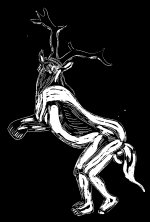A Visualization Exercise On The Elements
The Tetragrammaton
Let's start with the bible. (I'm sure a lot of pagans will be put off by this, but I believe that modern paganism is hugely influenced by a lot of Kabbalistic and Gnostic concepts, and it ill-behooves us to refuse to understand those influences).
The most common names for the Christian god are Jehovah and Yahweh. Both of these names are "best guesses" about how to pronounce the tetragrammaton -- the "four-letter name" of God that is transliterated as "YHVH" or "JHVH". In the original Hebrew, the four-letter name of God is spelled Yod-Heh-Vav-Heh. In Hebrew characters look like this (remember that Hebrew is read right-to-left):
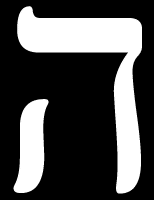


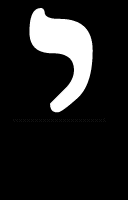
The reason the pronounciation is a "best guess" is because Jews never pronounce the four letter name of God. Since nobody was ever trying to pronounce it and because so much of language is based on doing the same thing other people do (and, to make matters more complicated, Hebrew has no vowels, so it's all the more important to learn how other people pronounce words), today, nobody really knows how this word was supposed to be pronounced.
By the time the Christians showed up two thousand years ago, they chose some pronounciations: Jehovah being the most popular.
Kabbalists often tell us that the four-letter name for God isn't actually a name at all; it's a formula for creation. It describes the process by which God created the universe. First, there was energy, rather formless and without direction, and that energy was received and worked out, before moving forward, and finally being made material.
The four elements (fire, water, air, and earth) are often used to represent these four stages of creation.
The elements are frequently associated with colours, as a sort of mental crutch: the two schemes that are the most common, in my experience, are red-yellow-white-black and red-blue-yellow-green. I'm going to stick with the latter colour scheme in this article. The Tetragrammaton, then, could be coloured in as follows:
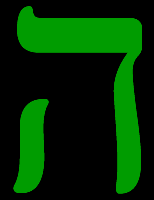
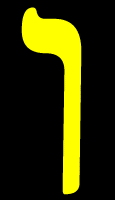


Rachel Pollack, in Seventy-Six Degrees of Wisdom, argues that the letter Heh appears cup-like, and suggests that the two Hehs represent the vagina or womb. (Of course, this perpetuates the idea of femaleness as being inherently passive and receptive). The Yod and Vav, then, might be considered phallic symbols. That seems to jibe with a common association of Air and Fire as the "male" elements, and Water and Earth as the "female" elements.
This idea of elements is fundamental to many forms of western esoteric thought. For example, the signs of the zodiac are each associated with an element.

(Notice the order of the colours as they go around the wheel).
The Golden Dawn
The Golden Dawn was a magical society that existed around the end of the 19th century. Although the Golden Dawn was a secrecy tradition, as the group was falling apart due to internal squabbles, one member (Israel Regardie) published the Golden Dawn system of magic, and that system appears to have heavily influenced British traditional Wicca (for more commentary on this, see Janet and Stewart Farrar's A Witches' Bible or Julia Phillips' article on the modern witchcraft movement). Many aspects of Wiccan ritual have drawn from the Golden Dawn, including stuff related to the elements.
In The Golden Dawn, Regardie describes how to use the "watchtowers" -- four tablets associated with the elements. Regardie describes how to arrange these tablets in a particular order to do certain types of magic:

One of the key ideas in modern paganism is duality: the most commonly used form of duality is gender. Consider this square as having two interesting axes: the male (Air-Fire) axis and the femal (Water-Earth) axis:

(In ancient Greek forms of thought, two forms of duality were most commonly associated with the elements: Hot-Cold duality and Wet-Dry duality).
Now we're ready to begin the fun stuff.
Theurgy
For whatever reason, Spirit or Divine Consiousness is often considered to be "up" in the heavens. So imagine that we are holding our four-coloured square up above our heads, and that, high above us, there is a Divine Consciousness.

Now, draw lines from the Divine Consciousness to the four corners of the tablets.

See where this is going? Let's tidy up this last picture a bit.
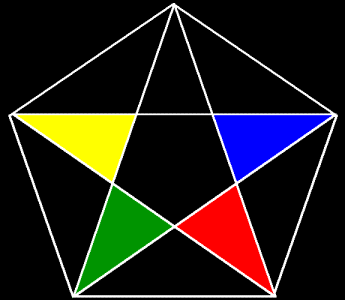
This pentacle shows the common Wiccan/Golden Dawn associations of the elements with five points of the star: Spirit (or Æther), Air, Earth, Fire, and Water. I like to think of Spirit as Æther because then they're all in alphabetical order, and that's easy to remember. Spirit, or the Divine Consciousness, then become the fifth element -- a concept from which we get the English word "quintessence".
Copyright © 2002 by B.C. Holmes. Last updated May 19th, 2002.
Back to my religion page.
